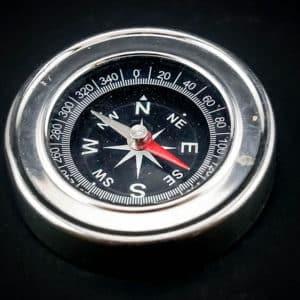
Place a straight stick straight upright in the ground so that you can see its shadow.

The taller the object is, the easier it will be to see the movement of its shadow. The narrower the tip of the object is, the more accurate the reading will be.

Make sure the shadow is cast on a level, brush-free spot.

Take your first reading in the morning, at least an hour before midday. Mark the tip of the shadow with a small object, such as a pebble, or a distinct scratch in the ground. Try to make the mark as small as possible so as to pinpoint the shadow’s tip.

Use a length of string exactly the same length as the first shadow you record.

Keep checking shadow’s length every 10-20 minutes. You will find that the shadow will continue to shrink as the time approaches midday, when shadows are at their shortest.

The shadow will begin to lengthen after midday. When the shadow grows to exactly the same length as your string from the first measurement, mark the spot.

Draw a straight line connecting the first and second marks as shown. This is your east-west line.

If you stand with the first mark on your left and the second on your right, you will be facing in the approximate direction of true north.

For an exact reading, your two marks need to be made at exact intervals before and after noon where you are, which means when the sun is at its highest point in the sky.

School science visits since 2004!
– Curriculum-linked & award-winning incursions.
– Over 40 primary & high school programs to choose from.
– Designed by experienced educators.
– Over 2 million students reached.
– Face to face incursions & online programs available.
– Early learning centre visits too!
Why Does This Happen:

Image courtesy Survival IQ
The shadow-tip method works by knowing that the Sun travels across the sky from East to West every day and that at some point in time the Sun has to reach its highest point of travel, i.e. midday. Midday time is different at every point on the Earth’s surface, so finding true north requires you to take a measurement at the location in which you are standing.
Midday time on your watch will be different to midday time found by the shadow method.
Towns and cities have been placed in ‘time zones’ so that people in a ‘timezone’ all operate off the same time. If your town is in the middle of a time zone your shadow method would have found midday to be very similar. However, if your town is on the edge of a time zone, your midday found by the shadow method may be quite different.
How can you find South using a constellation in the Southern Hemisphere?
Three steps…
1) Have a look up tonight and find Crux (the Southern cross). Draw an imaginary line from the top of the cross, through the bottom of the cross and keep going downwards towards the horizon.
2) Look to the west and you will see two bright stars called the Pointers. Draw an imaginary line between these two stars. Find the mid-point between the Pointers on this line and then draw a perpendicular line towards the horizon.
3) Where the line from Crux meets the line from the Pointers draw an imaginary line straight down to the horizon. You’ve found the direction for the South Celestial Pole.
From sunspots and asteroids to black holes & supernovae, the Stars & Planets and the Earth, Sun & Moon workshops have your unit on space covered!
Get in touch with FizzicsEd to find out how we can work with your class.
Earth, Sun and Moon
Years 3 to 6
Maximum 30 students
Science workshop (NSW & VIC)
60 or 90 minutes
Online Class Available
STEM Full Day Accelerator - Primary
Designed from real classroom experiences, this modular day helps you create consistently effective science learning that directly address the new curriculum with easily accessible and cost-effective materials.


























Comments